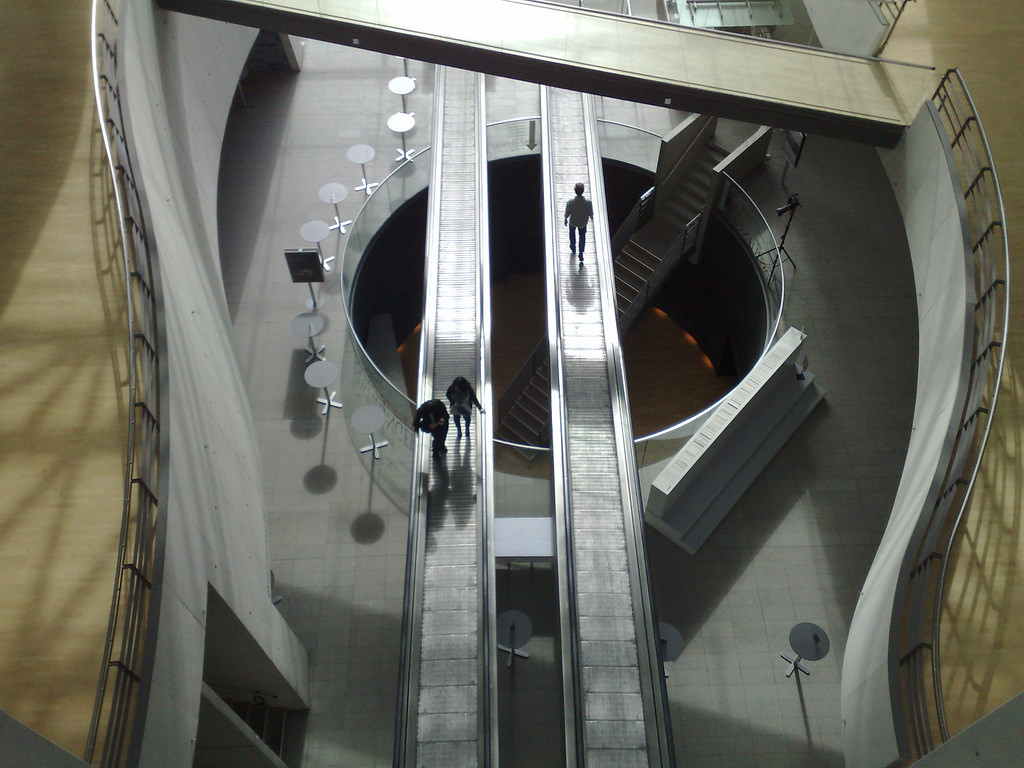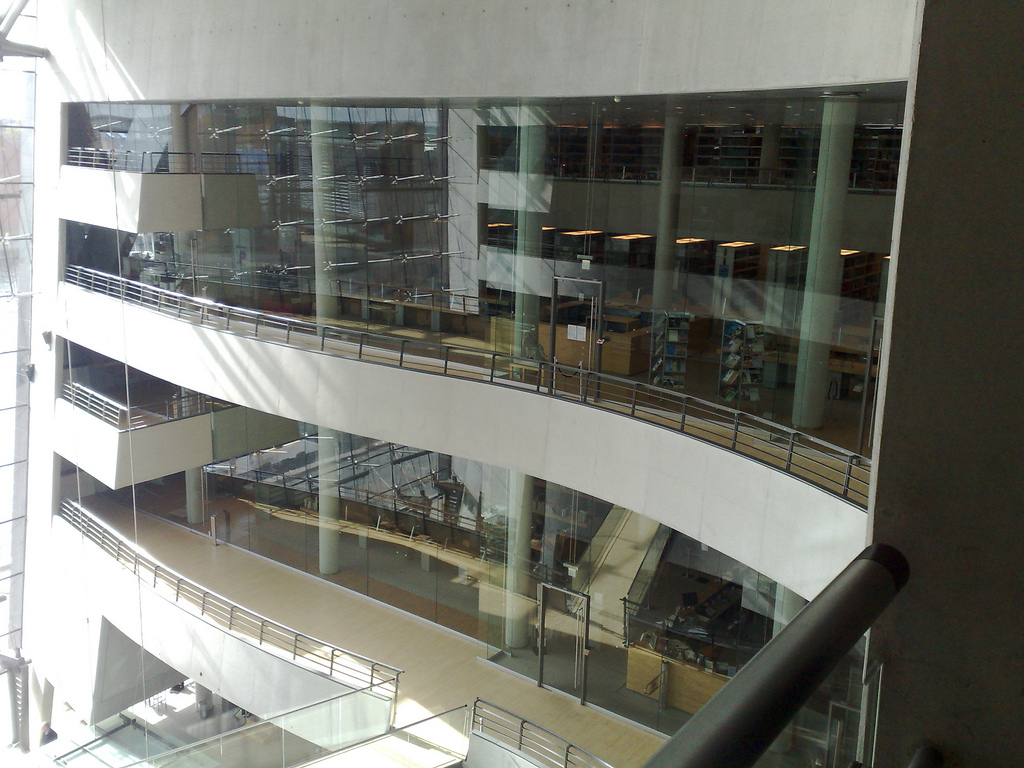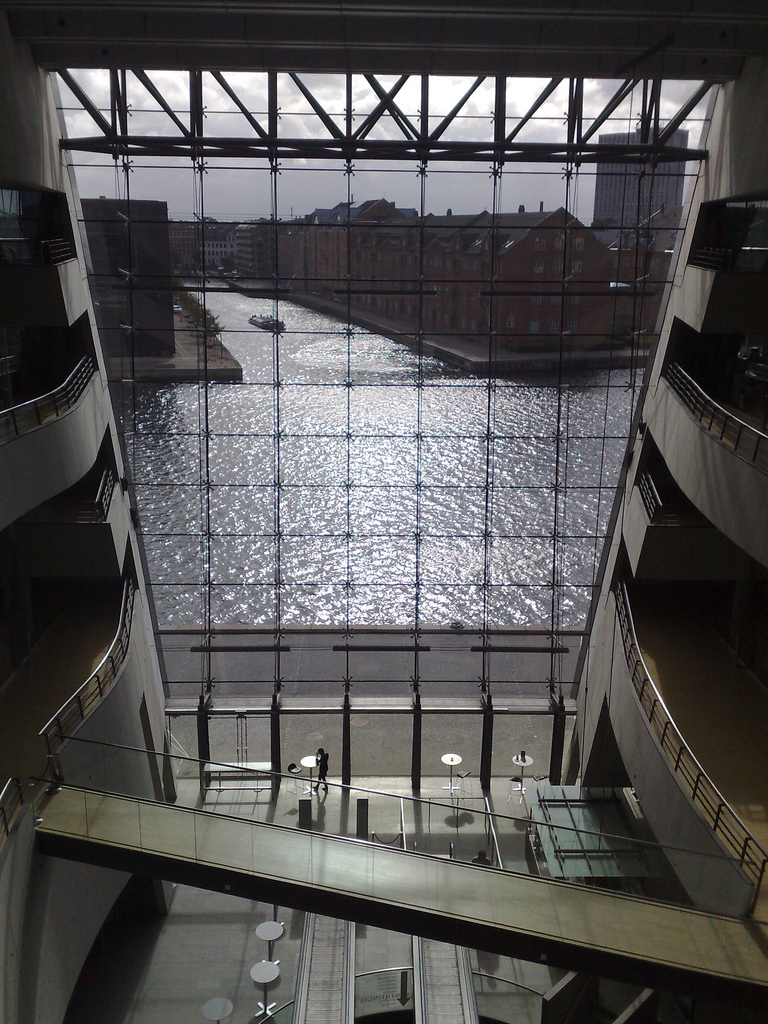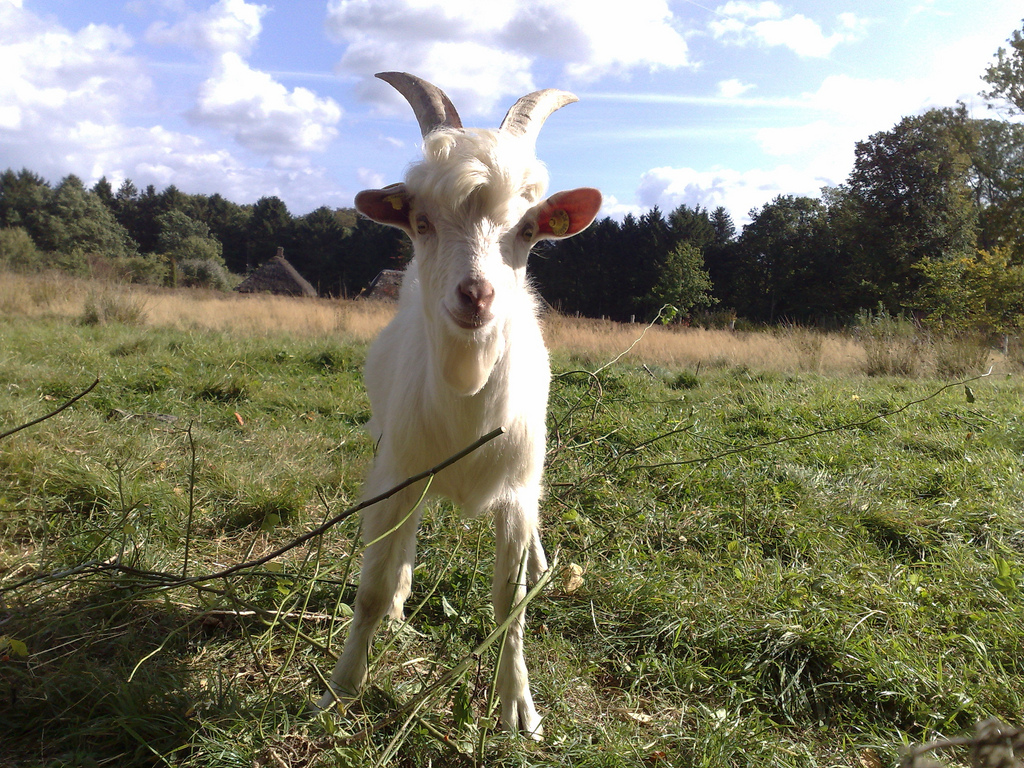The Royal Library in Copenhagen is a stunning example of bibliotecture: overlooking the inner-harbour, the “black diamond,” as it’s called, has a sweeping atrium surrounded by wavy balconies that you reach by taking a gently sloping moving sidewalk from the first floor. While the space is huge, it’s somehow not overwhelming – it’s the kind of space I could image spending a lot of time in quite comfortably.



My favourite part of the library, however, is not the architecture, it’s the music: every afternoon at 1:00 p.m. for three minutes one of 52 parts of a specially commissioned work titled Katalog plays in the atrium. The library explains what might seem an odd mixture of reading and music like this:
One may think that sound and reading rooms do not directly harmonize, and that students and scholars can be disturbed in their work. The library is already filled with real life sounds from the rolling travelators, general speech and activities at the A-level around The Queen’s Hall, in the Restaurant søren k, the café Øieblikket and the bookshop.
At 1 p.m. you have the possibility to look up from your books, stretch your legs and - for three minutes, no more no less - enjoy that the huge space is filled with music. Music which is experienced differently according to where you stand or move around.
In my talk last week I used The Royal Library as an example of a library space that typifies the “capabilities” systems design paradigm: the daily musical interlude is very much a part of this.
You can order a CD of 20 of the 52 parts of Katalog from The Royal Library; more information on ordering from this page on the library website.
The video and slides of my Applications vs. Capabilities talk last week at Access 2009 are now online. The interface is a little wonky, the OCR of my slides didn’t work that well, and I wandered around a lot, but the audio quality is quite good.
Well, where did that week go?
When we last talked I was about to get on a plane in Copenhagen and fly, via Frankfurt and Montreal, back home to Charlottetown. And I did. The flying was uneventful, and even featured a bit of Air Canada friendliness: I was able to get moved, thanks to a helpful gate agent in Frankfurt, from a middle seat to a lovely exit-row seat with endless leg room, making the trip across the Atlantic much, much more pleasant.
Tuesday morning I hit the ground running getting the wireless Internet set up for the Access 2009 conference, conveniently being hosted next door to our house in Murphy’s Community Centre. What was supposed to be an easy morning of Cisco setup turned into a two-day battle that ended up with the donated Cisco gear back in its packing boxes and my home Meraki gear set up to serve the conference – a big jump from serving the CBC Kids needs of Oliver to serving the network needs of 100+ systems librarians. In the end it all worked out – more on this later – and by Thursday I was ready to start assembling my own Access 2009 talk, scheduled to be delivered first thing Friday morning.
As is my habit, this was a “just in time” assemblage after several months of rumination, and what I ended up with was something I called Applications vs. Capabilities (you can find the slides here; the video should be along soon). The general idea was that you can design a system by creating applications, or you can design a system by building capabilities: I argued that we used to do the later, but since industrialism we’re doing more of the former, especially in libraries.
Friday morning arrived and I managed to get the talk out without collapsing from jet lag or lapsing into confused babble. The response fell into two distinct camps: “I’ve felt the same thing for a long time” and “you have no idea about what libraries are about.” It’s always fun to talk to the library audience, as they’re all smart people doing interesting things, and if I managed to influence a few of them in the capabilities direction, I’m happy.
With the presentation out the door, I returned to my role as father, and Oliver and I spent the rest of Friday rambling about, finishing up with a great Toy Story / Toy Story 2 double bill in 3D at Empire Theatres with my mother (we used the new-style online ticketing system, prompted by Billy’s blog post and it worked well).
Saturday morning I took in Mark Leggott’s parade of acronyms at Access (buried beneath the acronyms is some exciting work) and the joined the regular Saturday morning market routine with Oliver and my mother, which culminated in an impulse purchase of a Nintendo Wii, something that’s been entertaining us ever since (and has turned Oliver into a bowling fiend).
Finally today I’m back in the office banging out code after two weeks away.
Regular programming will resume Monday.
Since we last talked I’ve had a pleasant four days rambling around Copenhagen, having the sort of completely-work-free vacation I haven’t had, at least by myself, in several years.
Thursday morning I loaded up my iPod with an audio walking tour of the Copenhagen inner harbour from Copenhagen X narrated by Richard Swett, former U.S. ambassador to Denmark, and headed around the corner to the waterfront and toured away. I started at the awe-inspiring Royal Library then caught the harbour bus up past the Opera House, and on to Kastellet, the fortifications at the north end of downtown. I highly recommend the walking tour: Swett does a good job, and there’s lots of interesting commentary packed in.
After a stop at Kafferiet, one of the city’s nicest coffee shops, and an old favourite of mine, I headed to the Danish Art and Design Museum around the corner where I spent a pleasant hour in the museum’s library browsing their collection of design and typography books. After a quick lunch I walked downtown and, not yet completely full of museums, found the Post & Tele Museum, which turned out to be a rather uninspiring review of the history of mail and telephony with a slightly-more-interesting climate change exhibition (climate change being all the rage here).
Feeling finally museumed out and in need of place to rest up, I found my way to the Grand Teatret movie house where I accidentally ended up watching the French-language film Sommertid, forgetting that in Denmark the subtitles on a French-language film are in Danish (mirroring my experience from last year with The Band’s Visit… I should know better by now). I was so exhausted from my hectic day that I believe I may have fallen asleep half-way through the movie and missed a large chunk of the plot; either that or in my confused Danish-French state, I missed enough of the point that the movie only half-registered with me.
After a quick supper, post-movie, at my favourite shawarma hut on Strøget — the main shopping street of the city — I headed over to Copenhagen JazzHouse where I joined a crowd evenly split between beardy intellectual old-school jazz fans and young hipster jazz fans for a Benny Golson concert. Golson is an 80 year-old American tenor sax player who’s spent a life playing with a cross-section of anyone who’s been anyone in jazz; he’s an excellent player, was backed by a crack local trio, and his sets were sprinkled with stories of Coltrane and Gillespie. It was a thoroughly enjoyable night out.
Friday morning I rented a bicycle from my hotel (how-to video) and headed to Ricco’s coffee bar downtown on Studiestræde, the one Ricco’s I’d never visited. As usual the coffee was strong and the atmosphere decidedly burlap-and-album rock. After lolling about for a while I got back on the bike and headed up along “the lakes” to the flagship store of Normann — a retailer of high-end designery things — on Østerbrogade where I managed to secure exciting birthday gifts for [[Oliver]].
Just before noon, with minutes to spare, I dashed back downtown to La Gallette, a crepe place just around the corner from Ricco’s, for a lunch with Christian Dalager, a [[reboot]] friend with many overlapping geek passions. We shared a great meal of crepes with smoked salmon, crème fraîche and caviar and had a good opportunity to catch up.
After lunch I headed back out to Kastellet for another coffee at Kafferiet followed by a few hours of shooting practice for my bicycle rental video — most of the time spent getting used to being both host and camera-operator. I ended up ditching all my footage, but I had enough practice to allow me to record the entire thing in one take later in the afternoon on my way back to my hotel.
Friday night I met up with my old friend Jonas and we headed up to my neighbourhood from last year in the north-west for a very nice Italian meal at Tribeca NV. Jonas and I are forever meeting in train stations and going to dinner in interesting places — Oliver and I met him in London in the spring — and it’s always a pleasure to see him.
Saturday morning I started out early with a trip to Ricco’s again (are you starting to notice a trend?) and then caught the train out IKEA — a quick 20 minute ride followed by a short bus hop — both to feed my cultural anthropologist curiousity, to fill up on Swedish meatballs, and to shoot another bicycle-related video about the company’s program of letting out bikes for free to allow customers to get their purchases home. My primary observation at IKEA was that 80% of women in the store were pregnant, suggesting that if you’re outfitting a nursery in Copenhagen you go to IKEA.
Early in the afternoon I caught the train over to Malmö to make an early appearance for [[Luisa]]’s birthday party. After an unexpected delay and detour onto a city bus at the station just previous to my destination, I finally arrived and was immediately put to work chopping carrots and cucumbers and helping [[Olle]] pick up up ice from the Burger King.
The party itself got going after 8:00 p.m. and over the next few hours I got to meet a good cross-section of Luisa’s friends, all of whom gracefully accommodated my unilingual Englishness whenever I approached a conversation. Along the way I learned a lot about opera singing, the languages of northern Europe, the practice of bi-national Swedish-Danish relationships and myriad other things. Before I noticed it was 2:00 a.m. and I was bundled into a cab with the other Copenhagen-bound to head to the station for the train back home. I was rescued from a Canadian-credit-card-incapable ticket machine by a kind philosopher in a red ball cap and on the ride home got a good opportunity to talk climate change with a friend of Luisa’s who’s organizing an multi-site artist response to the issue.
I rolled into the hotel just after 3:00 a.m. dead tired and, surprising given the collection of cocktails I’d mixed for myself, fell instantly to sleep.
This morning, my last day in Europe, I had breakfast at the Danish Design Centre, toured their own (disappointingly esoteric) climate change exhibition, and then headed back to Malmö for a final lunch and opportunity to hang out with Olle and Luisa.
In the late afternoon I came back to Copenhagen, had a quick supper a Wagmama, and came back to HQ to pack up the Danish operation in preparation for a long day of air travel tomorrow — I leave CPH on a 7:00 a.m. flight to Frankfurt and land in Charlottetown just after 5:00 p.m. local time.
This has been yet another week of amazing experiences in wonderful Copenhagen, catching up with friends, meeting new friends, enjoying the pleasures of northern Europe and filling my head with a new set of crazy ideas for autumn.
I spent part of yesterday afternoon browsing through the excellent collection of design and typography books in the library of the Danish Museum of Art & Design here in Copenhagen. Among them was Typologia, a 1940 book by Frederic Goudy. Subtitled “studies in type design & type making : with comments on the invention of typography : the first types, legibility and fine printing,” the book is most remarkable for the wonders of its own typography. Set in University of California Old Style, it is a testament to the trade, and is almost enough to make me recant my digital lifestyle and return to the analog world of print production. A portion of the book, albeit in ugly browser-rendering, is available for reading online.

In my spare moments here in Copenhagen I’ve been trying my hand at short-video production and I’ve been posting the results on the ClimateChange.ThinkAboutIt.eu website. They range from 15 seconds to 4 minutes long; the Renting a Bicycle in Copenhagen video shows off the new Flip minoHD camera that all we bloggers were given as part of our climate change-blogging toolkit.
So today, with the climate change issue solved, I was free to start the vacation-like period of my trip to Copenhagen.
So as to not further exacerbate said climate change I decided to forgo my “lunch in Berlin, dinner in Geneva, breakfast in Zagreb” gallivanting plans and stay here in Copenhagen. Not much of a punishment, Copenhagen being as Copenhagen is.
Priority one this morning was to find coffee: after two days of weak filtered mud here at the hotel, I needed my coffee strong and well-prepared, and there is no better place for that in this neighbourhood than Ricco’s. So after a quick coffee-free breakfast at the hotel I walked up to Istedgade and had a heartbreakingly wicked espresso macchiato.
Fueled, I was was ready to head out on the town: destination Brede Værk, a newly reconditioned museum of Denmark’s industrial past. Getting there required an S-Train ride followed by a quick hop on a weird sort of forest trolley to the Brede station. In doing so I traveled from the heart of urban Copenhagen into a leafy post-industrial idyll.
Brede Værk, like all Danish museums I’ve visited, was well-organized, typographically dreamy, and with architecture as interesting as exhibitions. The only weak point was that, by renovating the old industrial buildings into contemplative, beautiful, whitewashed spaces, telling the “factory life in the last century could be a living hell” story was somewhat weakened. It’s hard to believe stories of lint-filled air and productivity-obsessed bosses when you’re walking around an air-conditioned hall where you could eat off the floor and quite happily move right in if the opportunity presented.
That all said, they did do justice to the complexities of factory life in a way usually absent from technical museums: the “factory floor” exhibit, all jazzed up with barcode-activated movie shows, told parallel stories of director, manager, shop steward, and veteran and new employees and the conflicts there-between: a considerable improvement over the simple “giant steam engines are amazing” one finds elsewhere.
After touring the factory and related exhibits on industrialism in Denmark I toured the grounds (that include a clock tower with the clock purposefully set to 7 minutes to 7, apparently with some sort of inspirational purpose — “it’s always about time to go to work”?) and spotted a sign pointing to “Frilandsmuseet” up the hill. Curious, I headed up the road, past a school and a parking lot, and found myself at the secret back entrance to the “Open Air Museum.”
A signpost said I was welcome to enter, as admission is free. So I did.
And immediately found myself in 1850s rural Denmark. Alone with the horses, and left free to wander in and out of myriad relocated farm buildings from places all over the country. I literally didn’t see another person for the first 30 minutes of my visit, and not having gone through any entry formalities, and not having a map, I felt a little bit like a member of a time-traveling Star Trek landing party.
Frilandsmuseet is huge, it turns out, with over 100 buildings, ranging from tiny houses to windmills to water-powered grist mills. There is pleasantly little “interpretation” — it’s limited to a single, subtle plaque outside each farm — and so it really does feel like rambling around in the past than anything like “learning.” There are animals and, eventually, gaggles of kindergarten children right out of central casting for “cute Danish children.”
I had lunch, I toured some more, and then found my way back to the forest trolley and headed back downtown.
One of my favourite things to do in Copenhagen, indeed one of my favourite things to do, period, is to visit my friend Luisa’s parents in the suburb of Valby: they are warm, generous, witty hosts and I always emerge well-fed and well-engaged. Tonight was no exception: after a late-afternoon flowers-and-gift shopping expedition I made my way to Valby where I was greeted by a house full of relatives and neighbours to celebrate Luisa’s birthday.
While I was assured this was in no way a “typical Danish birthday meal,” supper was hearty minestrone followed by waffles. (For supper! Waffles!) Good wine, strong coffee. A brilliant meal.
Being socially challenged as I am, there’s nothing better than sitting at the heart of a table of Danes speaking Danish: I’m left to exist in a pleasant netherworld, both there and able to observe there, to drop in and participate when the conversation lapses into English but delight in the indecipherable cacophony otherwise.
Happy Birthday was sung. In English and then its Danish equivalent Fødselsdag sang, a song that involves a lot of references to “hot chocolate and cakes” and much shouting of “Hurra!” and is way, way more fun.
As the night wore down there were stories of “insufficient postage” penalties, bank robberies, wine pricing and construction management techniques, many laughs shared, and then it was time to disappear off into the night.
All and all, an excellent start to a tiny vacation.
Longtime readers may recall my habit of killing airlines with my business. Well, now it’s happened to SkyEurope, the airline [[Oliver]] and I flew from London to Kosice in March. The 60 EUR ticket and the tatty Bulgarian Airlines plane were an early indication to me that SkyEurope my not have a sustainable business model.
So here I am in Copenhagen, leaving 5 tonnes of carbon emissions in my wake (about what driving 500 km a week — from Charlottetown, PEI to Yarmouth, NS — for a year in our 2000 Jetta would emit), to “exchange ideas and debate the issues of climate change” as part of the Th!ink About It Launch Event.
The theory is, I suppose, that my two days of interactions with 81 fellow bloggers from around the world — or at least from the climate change-causing part of the world — will catapult me back home filled with the verve to blog so passionately about the Prince Edward Island side of climate change to undo the damage I’ve done to the climate by getting here.
This requires either an intense belief in the power of the word, or a certain suspension of disbelief in the absurdity of the proposition. Or something of both.
This is not the only absurdity involved in the proposition, as these two days lay the groundwork for a 3-month blogging competition, a notion packed with its own weirdness.
I suppose if you twinge your mind to think of this as a sort of “climate change Booker Prize” it’s makes slightly more sense. Except that I’m fairly certain that Aravind Adiga did not set forth to write a novel urged on by the spirit of competitive writing.
As I’ve written many times before, I write this blog because it’s the best mechanism I’ve found for processing the hornet’s nest of ideas that clutter my mind. I do it for myself, not for an audience. Although the presence of an audience — the rigor that writing in public — is integral to the process, I’ve certainly never done it with any greater purpose in mind, nor to educate, inform, or publicize any deeper issue. If you happen to learn something by reading the words in this space, that’s an accident, not my intention.
So jumping into a trans-Atlantic telephone booth an emerging as a blogger with a purpose, and, what’s more, a blogger engaged in a pitched battle to out-blog eighty competing bloggers seems, at least on the surface, like a perversion of the process.
Absurd, you might say.
So here’s my rationale: I don’t actually care all that much about climate change.
Oh, I do go on about the importance of public transit. And I happen to think of cars as evil beasts cluttering up the city. And I’ve been known to indulge in some recreational carbon offsetting.
But I do not have the climate change fire in my belly.
I was unmoved by An Inconvenient Truth. I blithely pump gallons and gallons of oil into my uninsulated house every winter. I eat strawberries from California in the winter. And kimchi dumplings flown in from Seoul.
On an intellectual level I’m on-board, and I’m certainly not a climate change denier. But climate change indignation exists at a level roughly parallel to “inappropriate typeface indignation” in my day to day life.
And while it might seem even more absurd, what with my “oh yah, climate change” attitude, to come all this way for a town meeting of the climate change passionate, maybe that’s exactly why I’m here: to be the eyes and ears of the casually disinterested.
After all, if climate change is something to be addressed by mass individual action, surely it’s the hearts and minds of the casually disinterested coal-and-oil-swilling rich North Americans that must be won over.
So that’s where I’m starting, and that’s how I’m come to terms with the overarching absurdity of the enterprise.
Let’s see where I end up after two days of “Climate Change – the EU’s response,” “The Samso experiment – When an island turned green” and “On the Road to Copenhagen – stakes and state-of-play of negotiations.”

 I am
I am